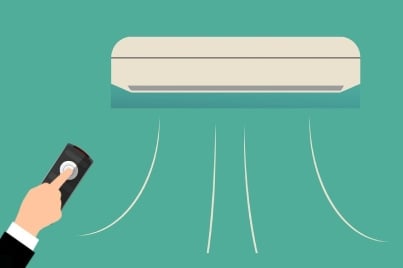Do you know the signs of poor indoor air quality? You can likely name a couple, but there's more to identifying indoor air pollutants than meets the eye. Or nose, for that matter.

There are many causes of air pollution, and often, it's difficult for humans to detect them. Because of this, it's essential to know the benefits of air quality testing if you're responsible for maintaining buildings and living spaces so you can identify many indoor air pollutants that are hard to detect.
Below is a guide for spotting indoor air pollutants and the signs to look for as you eradicate them.
How To Recognize the Indicators
Many factors can cause poor air quality, from unhealthy humidity levels to combustion byproducts to volatile organic compounds. These indoor air pollutants can wreak havoc on the human body.
Reports from the World Health Organization confirm that 3.2 million people around the globe die prematurely because of household air pollution. Environmental and health departments, like the WHO and the EPA, explain how geographical factors such as wildfires are key causes of pollution. In other cases, it can result from excess humidity and failure to test for mold growth.
So here's the million-dollar question: how do you recognize indoor air quality problems? The answer varies depending on the type of pollutant.
That said, here are five common ways to detect if a building is experiencing indoor air quality issues.
1. Respiratory Health Issues
Indoor air pollutants severely affect those with existing respiratory issues. However, they can also lead to long-term respiratory danger, even if you have no preexisting lung conditions.
If you or anyone in your office or living space experiences shortness of breath, tight lungs, or lung pain, these are clear signs to immediately test for a wide range of pollutants. Left untreated, they can cause long-term, and even terminal, respiratory disease.
Pollutants that damage respiratory health include:
- Combustion byproducts: Tobacco smoke, burning wood, carbon monoxide, particulate matter such as dust and dirt
- Natural substances: Radon, pet hair or dander, mold, mildew
- Volatile organic compounds: Certain gases released from paints, cleaning substances and disinfectants
- Construction and building materials: Lead, formaldehyde, asbestos
2. Lingering Odors
Don’t write unpleasant odors off as a simple annoyance. Some can be quickly identified, such as trash that hasn't been emptied or a dirty air conditioning filter. However, lingering odors might indicate the presence of polluted air.
For example, a smell that is pungent and sulphuric like rotten eggs can indicate the presence of a gas leak, which can be fatal in indoor spaces.
Another prime example is a lingering burning or fishy smell. These odors can indicate a looming electrical fire caused by overheating wires.
Lastly, lingering smells can come from organic compounds in carpets or cabinets, such as mold or mildew. Mold emits a musty smell and can result in shortness of breath, dizziness, headaches, and nausea.
3. Allergy Symptoms
Irritation of the eyes, throat, and nose are common allergy symptoms that can indicate dangerous indoor air pollutants.
These allergy-like symptoms come from the body's immune system and signify the activation of mucous membranes, which build a line of defense for internal organs against dangerous substances. These symptoms could be caused by the presence of polluted air in the lungs, throat, or eyes.
Allergy symptoms highlight the presence of the following airborne substances:
- Harmful particles, such as construction dust
- Mold spores or airborne bacteria
- Pesticides or disinfectants
- Tobacco smoke
4. Visible Mold Growth
The easiest way to spot mold is by looking for it. However, mold is sneaky and tends to grow in hidden places.
Mold relies on moisture for survival, so it often grows in damp areas with little ventilation.
Ultimately, identifying mold is simple once you know what signs to look for and where to look for them. If you suspect that you have mold, start by looking in the least ventilated areas. These areas are often inside cabinets with plumbing, such as under sinks or near laundry machines, under carpets, and behind wallpaper. You might need to do some excavating to confirm the presence of mold.
As you look, check for any surface discoloration or stains that are brown, black, green, or blue.
If inhaled over a long period of time, mold can be highly dangerous, so it must be eradicated as quickly as possible. At first, it can cause coughing, wheezing, and burning in the eyes and throat. Long-term exposure can lead to serious conditions like Legionnaires' disease or chronic respiratory issues.
5. Discomfort and Fatigue
Many people don't often associate headaches, nausea, fatigue, and dizziness with indoor air pollutants. Instead, most people assume that they’re the product of a contracted virus, such as the flu.
However, these symptoms might indicate a high concentration of harmful compounds, such as carbon monoxide and carbon dioxide. If inhaled over long periods, these gases result in tissue damage and even death.
To know if your air contains dangerous amounts of harmful substances, keep track of how you feel after leaving an environment. If the symptoms subside after you leave, that likely indicates the presence of deadly gases or volatile organic compounds.
Take Action for Better IAQ
Indoor air quality testing is becoming more accurate each year. For example, Internet of Things technology has redefined how building managers test and monitor pollution causes. By choosing a robust network of internet-connected hardware sensors, along with cutting-edge software for harvesting data, it's possible to automate indoor air quality testing for harmful substances like mold, radon, and carbon monoxide to improve your indoor environment.
Consider Attune's Internet of Things solution for your indoor environment. Our fully customizable indoor air quality solution uses enterprise-grade technology to promote health, wellness, and building safety. Investing in our solution provides you with a network of sensors that meet unique needs and test air continuously in both living and office spaces. As a result, you gain real-time data concerning the state of your indoor air quality.
Simply put, you can't rely only on your senses to identify the signs of poor indoor air quality. The health of your building's occupants depends on reliable, accurate, and continuous IAQ monitoring.
Schedule a demo today and discover how our solution can improve your indoor environment.

